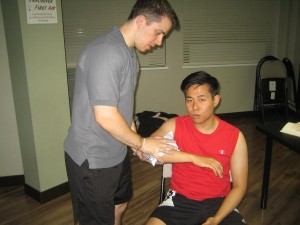Severe bleeding can occur in various injuries whether at home or in the workplace. It is vital that you are prepared with what to do once an individual ends up with severe bleeding.
Steps in managing severe bleeding
- If possible, wash hands using water and soap before touching the bleeding area. Do not wash the wound except with dog or cat bites or chemical burns.
- If synthetic gloves are available, they should be used to protect from possible transmission of diseases from the blood. Otherwise, avoid contact with blood if possible.
Continuous pressure must be held for at least 20 minutes before checking to see if the bleeding has stopped. - Remove or cut clothing over the wound to assess the area.
- If severe bleeding is coming from the trunk and internal organs are evidently bulging out, do not attempt to push them back inside. All you have to do is cover the wound using a dressing to prevent foreign contaminants from entering the area.
- The objective is to control the bleeding, thus you should not probe around the wound to remove objects or clean it. The best time to remove any debris or objects is if they are on the surface of the wound.
- If the body organs are not involved, you can apply direct pressure on the wound. The purpose of pressure is to help blood form a clot at the wound site. You can utilize a dressing pad but if not available, other alternatives include a clean towel or cloth that can absorb the blood.
- For large-sized or deeply embedded objects, do not attempt to remove them or apply direct pressure since this can make the bleeding worse. The removal should only be performed by healthcare professionals.
- If possible, you have to elevate the affected area. Always bear in mind that elevation helps in reducing the flow of blood to the area which reduces the pressure at the area and helps clotting form better.
- Continuous pressure must be held for at least 20 minutes before checking to see if the bleeding has stopped. If blood seeps through the dressing, it should not be removed since this will dislodge the clot and the bleeding starts again. All you have to do is apply second padding on top and reapply direct pressure.
What to do if maintaining pressure is difficult?
In case it is hard to maintain the application of direct pressure on the wound using your hand, you can bind the wound using a bandage or strips of clothing and secured using any type of tape if available. Always bear in mind that sufficient pressure is applied to help with the clotting process.


